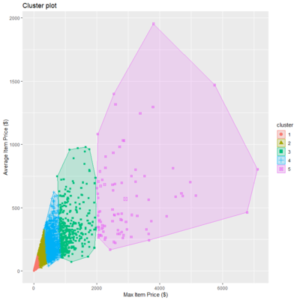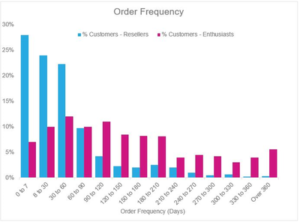Not All VIPs Are Created Equal: Get to Know Your Most Valuable Customers Better
November 27, 2018Investing time and money on your VIPs is never a wrong tactic, but you can make it even more personalized, and profitable. A new experiment by Optimove tells the tale of the Resellers and the Enthusiasts.
When exploring e-commerce client data, we often run into different active customer personas from which we might benefit.
The most common separation is between standard active customers and VIPs. As the Pareto Principle states, roughly 80% of the effects come from 20% of the causes. When applying this principle to the eCommerce industry, we see the same effect time after time: 80% of the revenue is generated by 20% of the customers.
Recently, during an interesting chat with one of our clients, we discussed the possibility of going deeper into our VIP breakdown: what if these VIPs could be split into many diverse groups?
In this case, the separation into having Resellers and Enthusiasts made a lot of sense, but not every e-commerce business is built in a way that supports the existence of different kinds of VIPs, and the terms, of course, may vary between one brand and another.
In our case, and after exploring dozens of e-commerce brands, we came up with a unique separation – to Resellers and Enthusiasts with the following approach:

What is the difference between an Enthusiast and a Reseller?
The Reseller is a pretty common definition in the e-commerce industry. It refers to customers who make high volume purchases of cheaper items, in order to make a profit when selling these items to their own clients for a marked-up price.
The Enthusiast is a client that loves your product and is willing to pay a high price for it. The definition of the Enthusiast may vary among different brands, for example: a brand that sells art might call them ‘Collectors’, whereas a photo equipment brand might call them ‘Professionals’, etc.
Both Reseller and Enthusiast have different behavior from the standard Active customer, but there are no similarities between the two:

How can we distinguish Enthusiasts from Resellers?
When trying to identify customers belonging to these two persona types, there are two attributes for each that we should look at. In this case, we used cluster analysis to identify these customers.
Resellers: The two main attributes that we should take into consideration when we try to identify Resellers:
- Number of Orders
- Number of Items Per Order
The combination of these two may help us detect a reseller early on in their journey as a customer. It might be enough to see that a customer ordered a huge number of items in their first order to flag them as a Reseller. But, if the customer ordered many items, although not a significantly high number of times, it might take a few orders to identify their Reseller pattern.
Enthusiasts: The attributes that correlate with Enthusiast’s behavior:
- Average Item Price
- Max Item Price
An Enthusiast might not buy as frequently as a Reseller, but their purchases are very valuable. In this case, the attributes above might do the job perfectly. Please note that your brand’s SKU has a crucial impact on the existence of Enthusiasts, in the case that your catalog’s range of prices is short, you shouldn’t expect to find Enthusiasts within your customers.
The example below shows how a simple cluster analysis discovers Enthusiasts based on Max Item Price and Average Item Price:

Each dot in the plot represents a customer. The X-axis represents the maximum item price, while the Y-axis represents the average item price. In this plot, we created five clusters based on these attributes. Our Enthusiasts, those who have high Max Item Price and high Average Item price, are the dots within the purple area on the right.
That being said, the CRM professionals might have insights that the data can’t detect, such as personal relations. If a client is known as either a Reseller or Enthusiast, you should always flag them manually, in addition to using the cluster analysis.
So, we can define two types of VIPs, how can we benefit from it?
We know that Resellers and Enthusiasts have different behavior, and we know how to detect each. The next step is to use this knowledge to target our VIPs better and boost their value.
When developing marketing and campaign strategies, we should take into consideration the type of VIPs we might encounter. For example, contacting an Enthusiast with a new line of luxury items makes perfect sense, but the same interaction will go straight to the Reseller’s Junk folder. On the other hand, when trying to push a surplus product at a low price, we might want to reach the Resellers, rather than the Enthusiasts.
Another crucial aspect is the churn indication. As Resellers buy much more frequently than Enthusiasts, we should consider raising the flag of possible churn much earlier. The ordering activity varies between different brands among the e-commerce industry, but the pattern is clear, as stated above.
In the chart below, we can see the frequency distribution of Resellers and Enthusiasts belonging to one of our clients. In this example, we might consider a Reseller as churned after 90 days of inactivity, as only a small fraction (16%) of the Resellers’ frequency exceeded this period. On the other hand, for an Enthusiast, this is a very short period of inactivity and should not indicate churn.

In conclusion, defining different personas within your customer database may be very valuable for your marketing strategy. Look into your stock, asses your products and think about your clients; who they are, what they do and how they achieve their goals, to help you segment them better. In our example here, understanding the different behavior patterns of a company’s VIP segment allows the brand to communicate with its customers and offer them the best offers, with the most suitable content, at the best timing.


